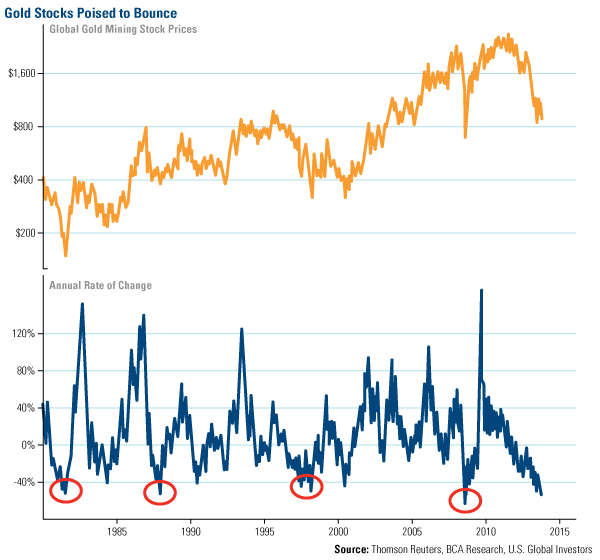Gold Market Radar (November 4, 2013)
For the week, spot gold closed at $1,316.20, down $34.6 per ounce, or 2.56 percent. Gold stocks, as measured by the NYSE Arca Gold Miners Index, lost 8.15 percent. The U.S. Trade-Weighted Dollar Index gained 1.91 percent for the week.
Strengths
- This week, Eldorado Gold announced the friendly acquisition of Glory Resources. Glory is focused on advancing the high-grade Sapes project, located about 15 kilometers from Eldorado's Perama Hill project in Greece. Glory reported that the Sapes project is compliant with the Joint Ore Reserves Committee (JORC) and has total proven and probable reserves of 637,000 ounces of gold at an average grade of 15.1 grams per tonne. Similarly, B2Gold has agreed to acquire the outstanding shares of Volta Resources through a friendly acquisition. Volta has an 81 percent interest in the Kiaka gold project in Burkino Faso with a potential to produce 340,000 ounces of gold. These two transactions continue to highlight our opinion that the cheapest resources already are listed, paving the way for more prolific mergers and acquisitions in the near future.
- Comstock Mining announced that Nevada regulators have approved a major modification to the company's Water Pollution Control Permit. This modified permit increases the amount of mineralized material the company may process annually from the previous 1 million tonnes of material per annum to 4 million tonnes per annum. The permit also authorizes the expansion of the company's existing heap leach pad facilities. According to the company’s CEO, the approval allows for an expedited heap leach expansion from five to eight cells, increasing rates of production and significantly dropping unit costs associated with producing the planned 40,000 gold-equivalent ounces for next year.
- Sell-side analysts and traders’ commentaries have highlighted a noticeable pickup in generalist and fundamental accounts buying large cap gold names in recent days. According to Macquarie, the move appears to be motivated by the fact that a lot of the bad news is already out there, and it’s likely for companies to surprise to the upside rather than perform negatively. As a matter of fact, Barrick Gold reported earnings this week showing a noticeable improvement on the bottom line, with earnings per share of $0.58 versus the analysts’ consensus of $0.51. Both gold and copper operations beat their operational targets, but the most significant improvement came on the cost side, where Barrick reported an 85 percent completion of its corporate downsizing program.
Weaknesses
- The spot gold price on the Shanghai Gold Exchange dropped below the London price this week, signaling that demand may be waning in the world’s second-largest gold market. Bloomberg reports that gold was selling at a 54.14 percent discount to the London price on Wednesday on very low volume in the Shanghai Gold Exchange.
- A recent International Monetary Fund (IMF) report shows that the gold holdings in Russia’s Central Bank fell for the first time since August 2012, decreasing 0.4 tonnes in September. However, Russia has added more than 50 tonnes to its gold reserves this year alone and about 600 tonnes since 2007. It is expected that gold purchases by central banks will decrease to 350 tonnes this year from 544 tonnes in 2012. Despite the decrease, analysts agree that central banks will remain substantial net buyers of gold in years to come.
- During the release of its third-quarter financial results, Yamana Gold issued a warning to investors this week saying it may not reach its stated 2013 production target of 1.7 million gold-equivalent ounces. During the third quarter of 2013, Yamana reported production of 306,935 gold-equivalent ounces, trailing its third quarter 2012 production of 310,490 gold-equivalent ounces. The greatest disappointment came when CEO Peter Marrone commented that the company is not presently in a position to reiterate or amend its full year 2013 production guidance, leading investors to believe the company will miss its production estimate.
Opportunities
- Jeffrey Currie, an analyst with Goldman Sachs, suggested just under a month ago that gold miners should hedge their output and lock current prices. In his opinion, gold would be the next big short trade. Other analysts, including Tom Kendall of Credit Suisse, also followed with negative commentary on the gold market, adding their names to the short-selling list. It’s interesting that this group dares to recommend that investors do the exact opposite of what asset allocation studies show: adding gold and gold stocks to a portfolio can add alpha without a significant increase to risk. Not only are these analysts ignoring proven academic research, they seem to be ignoring reality. BCA Research published a report at the end of last week highlighting that gold prices have failed to rise in recent months in spite of a weak dollar, adding that a catch-up is likely. BCA argues that gold is oversold on a technical basis, as seen in the chart above, which in itself could be enough to drive a gold rally above the $1,500 per ounce threshold.
- This week, RBC Capital Markets published the fifth part of its study on capital and operating cost expectations in the gold market. In the report, RBC underlines that capital costs have stabilized while all-in sustaining costs could fall by $150 per ounce in 2014 alone. RBC argues that since prices have fallen by a larger extent than all-in costs, this should discredit gold producers’ efforts to maintain or increase their returns on capital. After rising by 60 percent over the past three years, it appears 2014 may actually be a good time to build projects given the availability of engineering and equipment. Those companies that learned the importance of protecting balance sheet integrity and returns on capital will be the biggest beneficiaries of this new stage in capital costs, at the expense of those who were growing for the sake of growing.
- Mineweb contributor Dorothy Kosich reports that in a rare show of bipartisanship, Congressional Democrats and Republicans introduced a comprehensive bill aimed at fostering and facilitating the domestic growth of critical minerals to prevent future supply shocks. This highlights the urgent need to facilitate the development of American mineral deposits. The ultimate purpose of the bill is to ensure that officials are required to set, and adhere to, timelines and schedules for completion of reviews as well as for inspection and enforcement activities in the mining sector. According to Hal Quinn, CEO of the National Mining Association, the slow and inefficient permitting system in the U.S. is the largest impediment to unlocking the full value of American minerals, adding that the U.S. relies on foreign countries such as China to supply many of these critical minerals.
Threats
- David Zervos of Jefferies wrote quite an entertaining and ironic takedown on Janet Yellen’s nomination to the Federal Reserve Chairmanship. According to Zervos, the most exciting part about having Yellen in the seat is her inherent mistrust of market prices and her belief in irrational behavior processes. Zervos adds that there likely will be a day in 2016 when unemployment is still well above Yellen’s estimate and the headline inflation rate is above 4 percent, in which the Fed’s models will still show a big output gap and lots of slack. This way, Yellen could continue talking down inflation risks. In fact, Zervos argues that Yellen’s obsession with filling the output gap makes for a very real chance of policy mistakes down the road, similar to those resulting from an obsession with Keynesian mis-measuring of the output gap during the 1970s.
- Alan Greenspan published his new book “The Map and the Territory” in which he warns, among other things, that the “Spectacle of American central bankers trying to press the inflation rate higher in the aftermath of the 2008 crisis is virtually without precedent.” He follows up by commenting that this type of policy could easily trigger double-digit inflation. In light of this, David Rosenberg of Gluskin Sheff proposed a new mantra for the Federal Reserve: “Bring on inflation!” However, Rosenberg followed up by criticizing the Fed’s optimistic sentiment that inflation is good for economic growth, in which there is no widely accepted evidence or studies to support the assertion. For those who still believe in the Fed’s optimism after Wednesday’s meeting, consider Rosenberg’s list of market facts that show financial asset overheating: 1) valuations are no longer cheap, no matter the measure; 2) 80 percent of S&P stocks are trading above their 50 day moving average; 3) mutual fund and ETF inflows are at dot-com bubble levels; 4) NYSE margin debt just hit an all-time high; 5) portfolio managers are sitting on thin, 3.5 percent cash ratios; and 6) the VIX is sitting at 13 points, showcasing how few feel the need to buy downside protection. The list is simply too long to continue, but the point comes across easily.
- This week, the Mexican Senate approved the Fiscal Reform package passed last week by the Chamber of Deputies. Among other things, the package consists of a special mining fee of 7.5 percent on EBITDA and a 0.5 percent royalty on gross earnings. According to BMO Capital Markets, the new fiscal levies will result in significant negative impacts, ranging from 0 to 15 percent, to the net asset value (NAV) of companies with Mexican exposure. Among the most affected are companies such as Timmins Gold, MAG Silver and Pan American Silver, which have a 100 percent valuation exposure to Mexico.
















